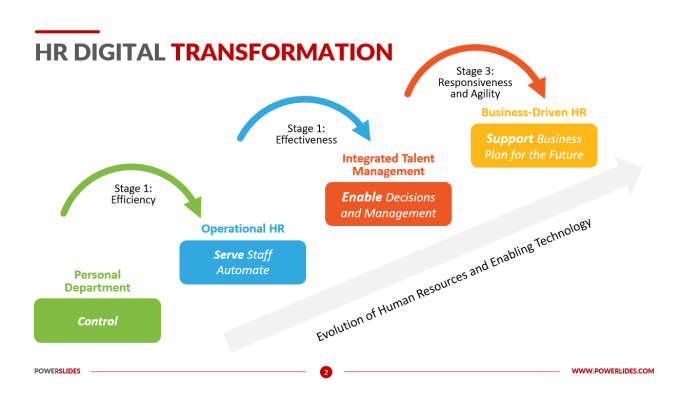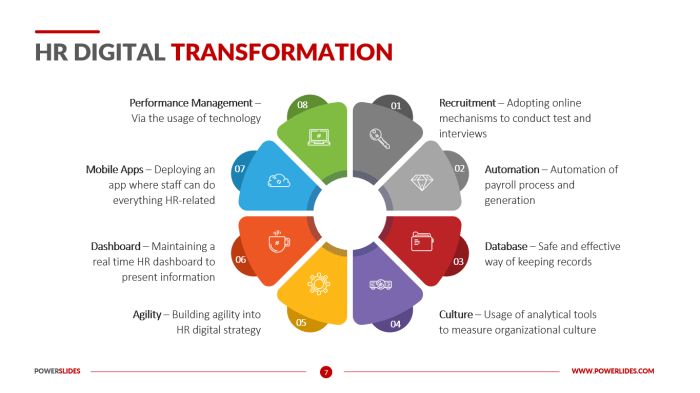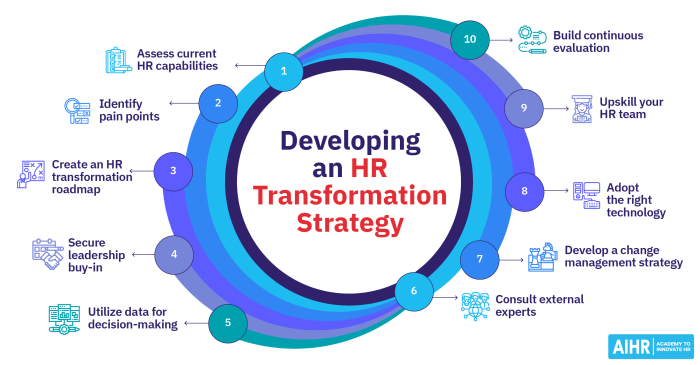Embarking on The Ultimate HR Digital Transformation Roadmap for Modern Workplaces, this introductory paragraph aims to pique the interest of readers with a detailed overview of the topic at hand.
Further details on the subject are elaborated in the subsequent paragraph for a comprehensive understanding.
Introduction to HR Digital Transformation

In the fast-paced digital age, HR digital transformation has become a critical aspect of modern workplaces. It involves leveraging technology to streamline HR processes, enhance employee experience, and drive organizational success.
Impact of Digital Transformation on HR Processes
- Automation of routine tasks such as payroll processing, attendance tracking, and recruitment, freeing up HR professionals to focus on strategic initiatives.
- Implementation of cloud-based HR systems for seamless data management, analytics, and reporting, leading to more informed decision-making.
- Utilization of artificial intelligence and machine learning in talent acquisition, performance management, and employee engagement to improve efficiency and accuracy.
Importance of Adopting Digital Tools in HR Functions
- Enhanced Employee Experience: Digital tools enable HR to provide personalized experiences to employees, leading to higher engagement and retention rates.
- Data-Driven Decision Making: By harnessing data analytics, HR can make informed decisions regarding recruitment, training, and performance evaluation, ultimately driving business outcomes.
- Cost Efficiency: Digital tools reduce manual errors, save time, and optimize resources, resulting in cost savings for the organization.
Key Components of HR Digital Transformation

In the realm of HR digital transformation, certain key components play a crucial role in reshaping the way organizations manage their workforce and talent.
Automation in HR Processes
Automation is a cornerstone of HR digital transformation, streamlining repetitive tasks, improving efficiency, and enhancing employee experience. By utilizing automation tools for tasks like payroll processing, employee onboarding, and performance evaluations, HR teams can focus on strategic initiatives and employee development.
Data Analytics in Driving HR Decisions
Data analytics empowers HR professionals to make informed decisions based on insights derived from workforce data. By analyzing metrics related to recruitment, retention, performance, and engagement, HR can identify trends, anticipate future needs, and optimize strategies to attract, develop, and retain top talent.
Implementing Technology in HR
Technology plays a crucial role in the digital transformation of HR processes, enabling organizations to streamline operations, enhance employee experiences, and improve overall efficiency.
Types of Technology in HR Digital Transformation
There are various types of technology commonly used in HR digital transformation, including:
- Human Resource Information System (HRIS): HRIS software helps manage employee data, payroll, benefits administration, and performance evaluations.
- Applicant Tracking System (ATS): ATS software automates the recruitment process, from job postings to candidate selection.
- Learning Management System (LMS): LMS platforms facilitate employee training and development through online courses and resources.
- Performance Management Software: These tools enable organizations to track employee performance, set goals, and provide feedback.
Examples of Software Solutions
Several software solutions are available to streamline HR operations, such as:
- Workday: An all-in-one HRIS platform that integrates payroll, HR, and finance functions.
- SAP SuccessFactors: A cloud-based HR suite that includes modules for talent management, workforce analytics, and employee engagement.
- BambooHR: A user-friendly HRIS system that centralizes employee data, time-off tracking, and performance management.
Benefits of Cloud-Based HR Systems
Cloud-based HR systems offer numerous advantages for modern workplaces, including:
- Accessibility: Employees can access HR information anytime, anywhere, promoting remote work and flexibility.
- Scalability: Cloud solutions can easily scale with the organization's growth and adapt to changing needs.
- Cost-Effectiveness: Cloud-based systems eliminate the need for on-premise infrastructure, reducing IT costs and maintenance.
- Data Security: Cloud providers offer robust security measures to protect sensitive HR data from breaches and cyber threats.
Enhancing Employee Experience through Digital Transformation
Digital transformation plays a crucial role in enhancing the overall employee experience within modern workplaces. By leveraging technology effectively, organizations can create a more engaging, productive, and supportive environment for their employees.
Role of Self-Service Portals in Empowering Employees
Self-service portals are a key component of digital transformation in HR. These portals empower employees by providing easy access to essential information, such as benefits, payroll, and training materials. By enabling employees to find answers to their queries independently, self-service portals save time for both employees and HR professionals, leading to increased efficiency and satisfaction.
Leveraging Technology for Better Communication and Collaboration
Effective communication and collaboration are essential for a successful workplace environment. Through digital transformation, organizations can utilize various tools and platforms to facilitate seamless communication and collaboration among employees. From instant messaging apps to project management tools, technology enables employees to connect, share ideas, and work together efficiently regardless of their physical location.
This not only improves teamwork but also fosters a sense of community and belonging among employees.
Change Management and Training
During HR digital transformation, change management plays a crucial role in ensuring a smooth transition. It involves strategies to help employees adapt to new technologies and processes effectively.
Strategies for Managing Change
- Communicate openly and regularly with employees about the upcoming changes.
- Involve employees in the decision-making process to make them feel valued and engaged.
- Provide training and support to help employees develop the necessary skills for the new technologies.
- Anticipate and address resistance to change through active listening and empathy.
Importance of Training Programs
Training programs are essential for employees to adapt to new technologies and processes effectively. They help in enhancing skills, boosting confidence, and increasing productivity.
- Offer hands-on training sessions to allow employees to practice and apply new skills in a safe environment.
- Provide continuous learning opportunities to keep employees updated on the latest technologies and best practices.
- Evaluate the effectiveness of training programs through feedback and assessments to make necessary improvements.
Best Practices for Fostering a Digital Change Culture
- Lead by example by embracing digital tools and technologies yourself.
- Create a supportive environment where employees feel encouraged to try new technologies without fear of failure.
- Reward and recognize employees who adapt well to digital changes to motivate others.
- Encourage collaboration and knowledge sharing to facilitate learning and adaptation to new technologies.
Measuring Success and Continuous Improvement

Measuring the success of HR digital transformation is crucial for organizations to understand the impact of their efforts and make necessary adjustments for continuous improvement. Key performance indicators (KPIs) play a vital role in evaluating the effectiveness of the digital transformation process.
Defining Key Performance Indicators (KPIs)
- Employee Engagement: Measure the level of employee engagement before and after the implementation of digital tools and processes.
- Time and Cost Savings: Track the time and cost savings achieved through automation and efficiency improvements.
- Talent Acquisition and Retention: Monitor the impact of digital transformation on attracting and retaining top talent.
- Compliance and Risk Management: Assess the effectiveness of digital solutions in ensuring compliance and managing risks.
Importance of Feedback Loops
Feedback loops are essential for continuous improvement in HR digital transformation. They allow organizations to gather insights from employees, managers, and other stakeholders to identify areas for enhancement and make informed decisions.
Ways to Iterate and Evolve the Digital Transformation Roadmap
Feedback and data analysis are the driving forces behind the evolution of the digital transformation roadmap.
- Regular Feedback Surveys: Conduct surveys to collect feedback on the usability and effectiveness of digital tools.
- Data Analytics: Analyze data on key metrics to identify trends, patterns, and areas for improvement.
- Pilot Programs: Implement pilot programs to test new technologies and processes before full-scale implementation.
Last Point
Concluding with a captivating summary, the outro paragraph wraps up the discussion on a high note, leaving readers with key takeaways.
FAQ
What are the benefits of cloud-based HR systems for modern workplaces?
Cloud-based HR systems offer scalability, flexibility, and easy access to data from anywhere, making them ideal for modern workplaces striving for efficiency and collaboration.
How can digital transformation improve employee experience?
By implementing digital tools and self-service portals, digital transformation can enhance employee engagement, streamline processes, and empower employees to take control of their work experience.
What are some key performance indicators (KPIs) for evaluating the success of HR digital transformation?
KPIs like employee engagement levels, time savings in HR processes, and adoption rates of new technologies can be valuable metrics in assessing the effectiveness of HR digital transformation initiatives.







